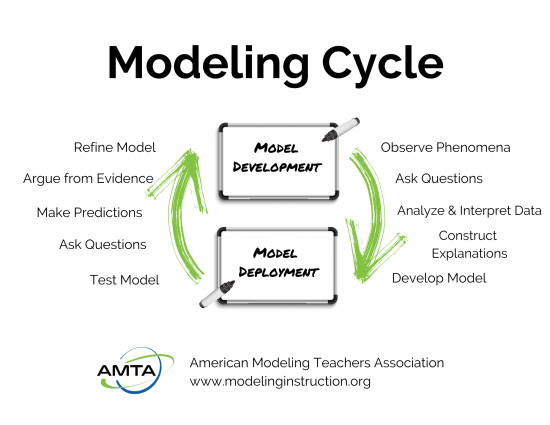
What is Modeling Instruction?
Modeling InstructionTM is a guided-inquiry approach to teaching science that organizes instruction around a coherent storyline of model development. This method provides content instruction while students are immersed in the process of doing science. Research has shown students in Modeling InstructionTM classrooms perform significantly better on measures of conceptual knowledge when compared to similar students in traditional classrooms.
How does Modeling Instruction work?

Modeling InstructionTM works within a flexible curriculum design that can be used in a variety of disciplines, from introductory classes through Advanced Placement courses. Modeling teachers act as facilitators and help students construct explanations and defend their conclusions with evidence.
In a Modeling classroom:
- Instruction is organized into modeling cycles which move students through all phases of model development, evaluation, and application in concrete situations.
- The teacher sets the stage for student activities to establish common understanding of a question to be asked. Then, in small groups, students collaborate in planning and conducting experiments to answer or clarify the question.
- Students present and justify their conclusions in oral and/or written form, including a formulation of models for the phenomena in question and evaluation of the models by comparison with data.
- Technical terms and concepts are introduced by the teacher only after students display conceptual understanding to sharpen models, facilitate modeling activities, and improve the quality of discourse.
What standards are addressed in Modeling InstructionTM?
Modeling InstructionTM is very well-aligned with the three dimensions of the Next Generation Science Standards. Students are involved daily with the science practices, disciplinary core ideas, and Modeling InstructionTM has a primary focus on the crosscutting concepts of systems and system models and energy and matter. Students will also leave a Modeling classroom with much improved 21st Century Learning Skills – critical thinking, collaboration, communication, and creativity.
How can teachers learn more about Modeling InstructionTM and professional development?
AMTA provides many opportunities for high-quality professional development throughout the spring and summer, both in-person and virtually. Visit our Upcoming Workshop page to learn more.
AMTA Sponsors

For nearly 30 years Vernier Science Education has supported Modeling InstructionTM and AMTA by the loan of equipment to workshops, donations of lab manuals as door prizes, discount certificates to workshop participants and technical support to teachers implementing Modeling InstructionTM in their classes. They provide a wealth of resources that enable students to explore science in new ways. For more information visit their website: www.vernier.com
Major Donors
Edith C Blum Foundation
Matthew Zell Family Foundation
Brandon Withrow
Colleen & Jack Megowan-Romanowicz Family Foundation
Thomas Egan
Fran Poodry
Recurring Donors
David Bates
Barbara Besal
Matthew Bryant
Kathryn Burch
Craig Buszka
Denise Byrd
Gerry Cacnio
Andrew Chapman
Alissa Clark
Glenda Connelly
Erin Conrardy
Karle Delo
Michael Dolan
Chantel Dooley
Larry Dukerich
Kay Fincher
Diana Gigante
Melissa Girmscheid
Sean Grealis
Matt Greenwolfe
Wendy Hehemann
Debra Hill
Ray Howanski
Jane Jackson
Mike Kennedy
Earl Legleiter
Dan Lorts
Urska Manners
Teresa Marx
Karle Myers
Margaret Molter
Geoff Nunes
Jeff Saul
Matthew Scheffler
Candace Schneggenburger
Mark Schober
Ernie Schwenk
Jeremy Secaur
Ariel Serkin
Laura Slocum
Jennifer Sosnowski
Jim Stankewitz
Marta Stoeckel
Mitch Sweet
Garfield Taylor
Bill Thornburgh
Kelli Warble
Michael Zitolo
Partner with AMTA
Your gift will help provide teachers with resources and training to bring more effective STEM instructional methods to learners around the world. AMTA offers a variety of financial support opportunities to match your company’s corporate social responsibility goals or personal charitable giving. In providing funds or in-kind donations to AMTA, you demonstrate your commitment to improving STEM education.
To inquire about sponsorship, please contact us using the button below. Thank you for your commitment to our educators and learners.
We cannot wait to work with you!
